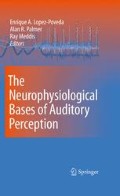Abstract
Corticofugal projections may modulate auditory signal processing at all levels of the ascending auditory system. The final link in this pathway, extending descending control to the cochlea, is the olivocochlear bundle, which originates in the olivary complex and consists of lateral and medial (MOC) systems. Classically, activation of the MOC system leads to an increase in cochlear microphonic and a decrease in cochlear action potential amplitudes.
Here, we investigated the effect of reversible cortical inactivation on the guinea pig cochlea. During cortical inactivation, CM and CAP amplitudes were decreased to varying extents. Reactivation of the cortex led to a recovery to control levels. These results indicate that even in the anaesthetized animal, the cortex is exercising control over the function of the cochlea.
Access this chapter
Tax calculation will be finalised at checkout
Purchases are for personal use only
References
Coomes DL, Schofield BR (2004) Projections from the auditory cortex to the superior olivary complex in guinea pigs. Eur J Neurosci 19:2188–2200
Delano PH, Elgueda D, Hamame CM, Robles L (2007) Selective attention to visual stimuli reduces cochlear sensitivity in chinchillas. J Neurosci 27:4146–4153
Fex J (1959) Augmentation of cochlear microphonic by stimulation of efferent fibres to the cochlea; preliminary report. Acta Otolaryngol 50:540–541
Galambos R (1956) Suppression of auditory nerve activity by stimulation of efferent fibers to cochlea. J Neurophysiol 19:424–437
Groff JA, Liberman MC (2003) Modulation of cochlear afferent response by the lateral olivocochlear system: activation via electrical stimulation of the inferior colliculus. J Neurophysiol 90:3178–3200
Guinan JJ (1996) Physiology of the oivocochlear efferents. In: Dallos P, Popper AN, Fay RR (eds) The cochlea. Springer-Verlag, New York, pp 435–502
Guinan JJ Jr (2006) Olivocochlear efferents: anatomy, physiology, function, and the measurement of efferent effects in humans. Ear Hear 27:589–607
Lomber SG, Payne BR, Horel JA (1999) The cryoloop: an adaptable reversible cooling deactivation method for behavioral or electrophysiological assessment of neural function. J Neurosci Methods 86:179–194
Meurice JC, Paquereau J, Marillaud A (1991) Same location of the source of P1 of BAEPs and N1 of CAP in guinea pig. Hear Res 53:209–219
Mountain DC (1980) Changes in endolymphatic potential and crossed olivocochlear bundle stimulation alter cochlear mechanics. Science 210:71–72
Mulders WH, Robertson D (2000) Effects on cochlear responses of activation of descending pathways from the inferior colliculus. Hear Res 149:11–23
Mulders WH, Robertson D (2006) Gentamicin abolishes all cochlear effects of electrical stimulation of the inferior colliculus. Exp Brain Res 174:35–44
Oatman LC (1971) Role of visual attention on auditory evoked potentials in unanesthetized cats. Exp Neurol 32:341–356
Oatman LC (1976) Effects of visual attention on the intensity of auditory evoked potentials. Exp Neurol 51:41–53
Winer JA (2005) Decoding the auditory corticofugal systems. Hear Res 207:1–9
Winer JA, Lee CC (2007) The distributed auditory cortex. Hear Res 229:3–13
Xiao Z, Suga N (2002) Modulation of cochlear hair cells by the auditory cortex in the mustached bat. Nat Neurosci 5:57–63
Author information
Authors and Affiliations
Corresponding author
Editor information
Editors and Affiliations
Appendices
Comment by Stefan Strahl
Did you observe any changes to the compound action potential waveform? In the context that the second negative potential (N2) can disappear in lession studies (e.g., Meurice et al. 1991) it might be interesting if any effects (e.g., to the latencies) of N1, P1 and N2 are observable in your experiments.
Reply Alan R. Palmer
We have normalized and compared the CAP waveforms measured before and during cooling. There is a change in the shape of the CAP waveform as the N1 component is reduced by a larger proportion than the N2 component and there is an increase in latency of about 0.5 ms. There was no gross change in the shape such as the loss of the N2 peak that occurs when the auditory nerve is sectioned as it leaves the internal auditory canal (Meurice et al. 1991).
Rights and permissions
Copyright information
© 2010 Springer Science+Business Media, LLC
About this paper
Cite this paper
Edwards, D., Palmer, A. (2010). Investigating Cortical Descending Control of the Peripheral Auditory System. In: Lopez-Poveda, E., Palmer, A., Meddis, R. (eds) The Neurophysiological Bases of Auditory Perception. Springer, New York, NY. https://doi.org/10.1007/978-1-4419-5686-6_6
Download citation
DOI: https://doi.org/10.1007/978-1-4419-5686-6_6
Published:
Publisher Name: Springer, New York, NY
Print ISBN: 978-1-4419-5685-9
Online ISBN: 978-1-4419-5686-6
eBook Packages: Biomedical and Life SciencesBiomedical and Life Sciences (R0)

